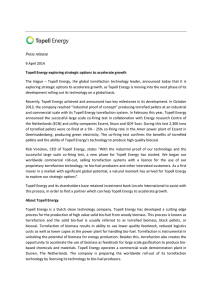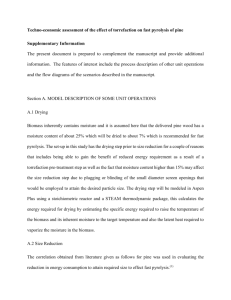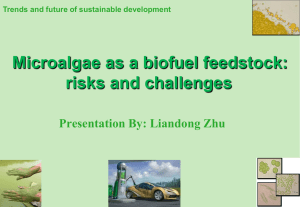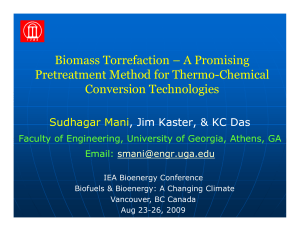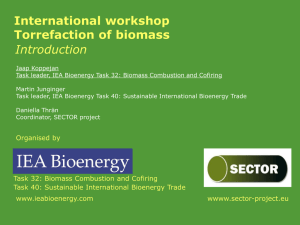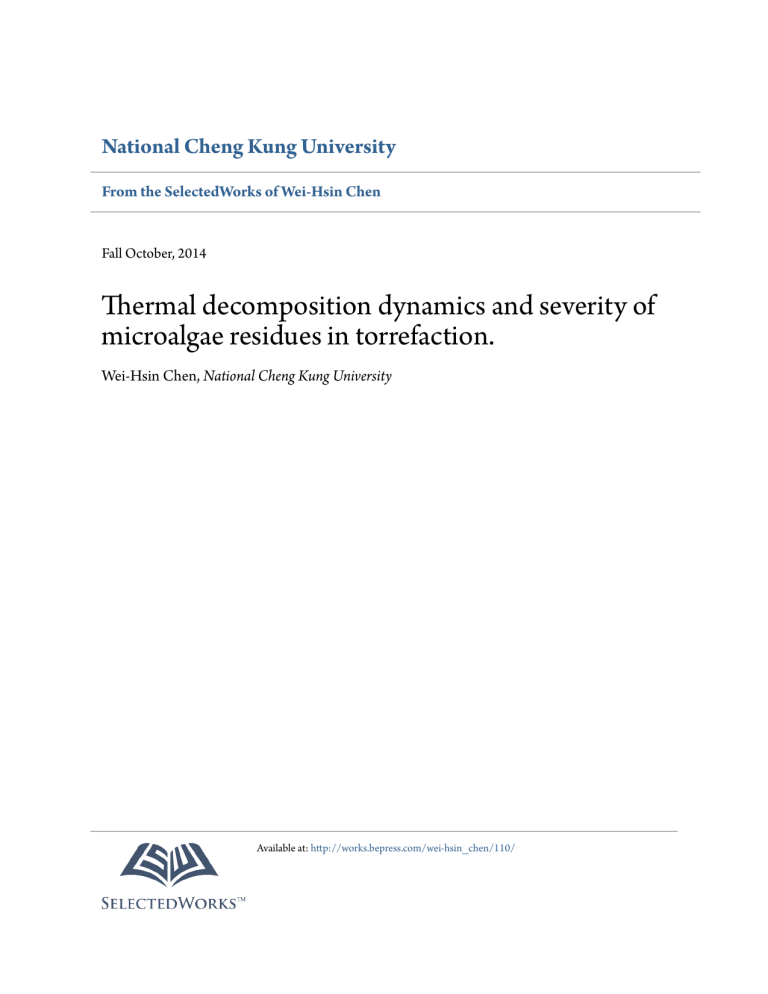
National Cheng Kung University
From the SelectedWorks of Wei-Hsin Chen
Fall October, 2014
Thermal decomposition dynamics and severity of
microalgae residues in torrefaction.
Wei-Hsin Chen, National Cheng Kung University
Available at: http://works.bepress.com/wei-hsin_chen/110/
Bioresource Technology 169 (2014) 258–264
Contents lists available at ScienceDirect
Bioresource Technology
journal homepage: www.elsevier.com/locate/biortech
Thermal decomposition dynamics and severity of microalgae residues
in torrefaction
Wei-Hsin Chen a,⇑, Ming-Yueh Huang a, Jo-Shu Chang b,c,d, Chun-Yen Chen c
a
Department of Aeronautics and Astronautics, National Cheng Kung University, Tainan 701, Taiwan, ROC
Department of Chemical Engineering, National Cheng Kung University, Tainan 701, Taiwan, ROC
c
Center for Bioscience and Biotechnology, National Cheng Kung University, Tainan 701, Taiwan, ROC
d
Research Center for Energy Technology and Strategy, National Cheng Kung University, Tainan 701, Taiwan, ROC
b
h i g h l i g h t s
g r a p h i c a l a b s t r a c t
Thermal decomposition and severity
a r t i c l e
i n f o
Article history:
Received 9 May 2014
Received in revised form 21 June 2014
Accepted 24 June 2014
Available online 1 July 2014
Keywords:
Torrefaction and pyrolysis
Microalgae residues
Torrefaction kinetics
Thermogravimetric analysis
Torrefaction severity index (TSI)
Torrefaction severity index
Torrefaction
C. sp. JSC4 residue
in N2
200-300 °C
0.8
High curvature
Intermediate curvature
0.6
0.4
C. sorokiniana CY1
residue
0-60 min
Curvature = 0
Low curvature
0.2
0
60
40
20
Torrefactio
n time
(min)
0
200
225
Tempe
250
rature
275
300
0
( C)
a b s t r a c t
To figure out the torrefaction characteristics and weight loss dynamics of microalgae residues, the
thermogravimetric analyses of two microalgae (Chlamydomonas sp. JSC4 and Chlorella sorokiniana CY1)
residues are carried out. A parameter of torrefaction severity index (TSI) in the range of 0–1, in terms
of weight loss ratio between a certain operation and a reference operation, is defined to indicate the
degree of biomass thermal degradation due to torrefaction. The TSI profiles of the two residues are similar
to each other; therefore, the parameter may be used to describe the torrefaction extents of various biomass materials. The curvature of TSI profile along light torrefaction is slight, elucidating its slight impact
on biomass thermal degradation. The sharp curvature along severe torrefaction in the initial pretreatment period reveals that biomass upgraded with high temperature and short duration is more effective
than using low temperature with long duration.
Ó 2014 Elsevier Ltd. All rights reserved.
1. Introduction
Microalgae have been considered as potential sources for
producing biofuels; this arises from the fact that they are characterized by rapid growth, high carbon fixing efficiency, and avoiding
⇑ Corresponding author. Tel.: +886 6 2004456; fax: +886 6 2389940.
E-mail address: weihsinchen@gmail.com (W.-H. Chen).
http://dx.doi.org/10.1016/j.biortech.2014.06.086
0960-8524/Ó 2014 Elsevier Ltd. All rights reserved.
1
Torrefaction severity index
of microalgae residues in torrefaction
are studied.
Microalgae residues are thermally
degraded in a thermogravimetric
analyzer.
Torrefaction severity index (TSI) is
defined to indicate torrefaction
degree.
The curvature of TSI profile reveals
the sensitivity of biomass thermal
degradation.
Biomass upgraded with high
temperature and short duration is
more effective.
the problems of food shortage (Sayre, 2010; Chen et al., 2012),
thereby achieving carbon capture and storage when they grow
and are harvested. On account of high lipid content in some microalgae, they can be employed for biodiesel production (Li et al.,
2008; Chisti, 2007). Microalgae can also be fermented to produce
bioethanol (Harun et al., 2010) and biobutanol (Jang et al., 2012).
For these reasons, microalgae are promising and crucial feedstocks
for third generation biofuels.
259
W.-H. Chen et al. / Bioresource Technology 169 (2014) 258–264
Nomenclature
A
Ea
k
n
R
R2
T
t
X
pre-exponential factor (min1)
activation energy (kJ mol1)
reaction rate constant (min1)
order of reaction ()
universal gas constant (=8.314 J mol1 K1)
coefficient of determination
temperature (K)
time (min)
conversion of sample ()
After microalgae undergo lipid extraction, the residues are
generally discarded or burned. The microalgae residues following
oil extraction, in fact, still contain carbohydrates, proteins, and
some lipids (Xu et al., 2011). For this reason, some studies, with
interest in extending the utilization of microalgae residues, have
been performed. For example, methane was recovered from the
anaerobic digestion of microalgae residues to improve the renewability of biodiesel conversion process (Ehimen et al., 2011). Biogas
was produced from the co-digestion of microalgae residues and
carbon rich substrates, with emphasis on the higher methane yield
of the co-digestion of the residues from amino extraction than
from lipid extraction (Ramos-Suárez and Carreras, 2014). A
carbon-based solid acid catalyst was synthesized from microalgae
residue by in situ hydrothermal partially carbonization with H2SO4
(Fu et al., 2013); it was found that the catalyst had high catalytic
activity and a well activity remained after the five-cycle regeneration. Low-molecular-weight maltodextrin was recovered in
carbohydrate hydrolysis with acid, for the purpose of gaining valuable carbohydrates remained in microalgae residues (Lam et al.,
2014). These evidences clearly suggest that the reuse of microalgae
residues is of great potential for commercial applications.
Pyrolysis, where biomass is thermally decomposed in an inert
or oxygen-free environment at temperatures ranging from 350 to
750 °C (Elliott, 2007), is a noticeable route to obtain biofuels form
microalgae and their residues (Miao et al., 2004). Unlike pyrolysis
for bio-oil production, torrefaction is a thermal process mainly for
solid fuel production. In torrefaction, biomass is also thermally
degradated in inert or oxygen-free environments but the temperature is between 200 and 300 °C (Du et al., 2014). In recent years,
biomass upgrade by torrefaction has received a great deal of attention, as a consequence of a number of advantages in improving the
quality of solid biomass fuels (Rousset et al., 2011; Chen et al.,
2012a; Lu et al., 2012, 2013). In reviewing literature relating microalgae and torrefaction, however, very few papers have been published. The study of Wu et al. (2012) revealed that the calorific
values of a torrefied microalga and its residue, pretreated at
300 °C for 30 min, were increased by the factors of 26.70% and
17.16% when compared to the untreated counterparts. Chen et al.
(2014) explored the isothermal and non-isothermal torrefaction
characteristics and kinetics of a microalga, and pointed out that,
under the same average temperature and torrefaction duration,
non-isothermal torrefaction gave more severe pretreatment than
the isothermal one.
Mass production of biofuels from microalgae is a promising
route for the applications of prospective alternative fuels, implying
that a large amount of microalgae residues is likely to be produced.
Despite numerous papers concerning biomass torrefaction
reported, the understanding of the torrefaction characteristics of
microalgae residues, especially in weight loss dynamics, remains
insufficient. This study aims to figure out the thermal degradation
dynamics of two microalgae residues in torrefaction, and a
parameter of torrefaction severity index (TSI) will be introduced
W
DWI
weight of sample (mg)
weight loss increment (wt%)
Subscript
0
i
f
ref
beginning of torrefaction
initial state (at 105 °C)
final state (at 800 °C)
reference operation (at 300 °C and 1 h)
to evaluate the impact of torrefaction temperature and duration
on biomass weight loss. The obtained results are able to provide
a useful insight into the further utilization of third generation
biofuels.
2. Methods
2.1. Material preparation and basic analysis
In the present study, two microalgae residues served as the
samples for torrefaction experiments; they were Chlamydomonas
sp. JSC4 (C. sp. JSC4) and Chlorella sorokiniana CY1 (C. sorokiniana
CY1) residues. The two biomass species were isolated from freshwater in southern Taiwan and pertained to oil-rich indigenous
microalgae (Ho et al., 2010; Chen et al., 2013). The lipids in the
two microalgae were extracted through the direct transesterification method (Su et al., 2007). After the oil-extraction of the two
microalgae, the residual solids were dehydrated in an oven at
105 °C for 24 h to minimize the interference of surface water.
Thereafter, the samples were ground into powders by a shedder
followed by sieving using a screen to particle sizes less than 40
mesh (i.e., <0.42 mm). The powders were collected in sealed plastic
bags and stored in a desiccator at room temperature until thermogravimetric analyses were carried out.
The basic properties of the two microalgae residues, such as
composition, proximate, elemental, and calorific (IKA C2000 Basic)
analyses, are tabulated in Table 1. In the composition analysis,
Table 1
A list of basic properties of two microalgae residues.
Biomass
C. sp. JSC4
C. sorokiniana CY1
Composition analysis (wt%)
Crude protein
Crude lipid
Carbohydrate
Others
12.18
6.85
35.70
45.27
18.81
9.90
35.67
35.62
Proximate analysis (wt%)
Volatile matter (VM)
Fixed carbon (FC)
Moisture
Ash
75.50
15.60
3.50
5.20
73.20
15.10
3.80
7.90
Photograph
Elemental analysis (wt%, dry-ash-free)
C
40.32
H
7.38
N
2.61
O (by difference)
44.50
Chemical formula
CH2.2O0.83N0.06
HHV (MJ kg1, dry basis)
17.41
45.07
7.64
3.88
35.52
CH2.03O0.59N0.07
20.40
260
W.-H. Chen et al. / Bioresource Technology 169 (2014) 258–264
crude protein, crude lipid, and carbohydrate were determined by
Kjeldehl method, Soxhelt-extract method, and phenol–sulfuric acid
method, respectively (Peng et al., 2001a). The proximate analysis
was performed in accordance with the standard procedure of
American Society for Testing and Materials, as described elsewhere
(Chen et al., 2011). The elemental analysis was carried out using an
elemental analyzer (PerkinElmer 2400 Series II CHNS/O Elemental
Analyzer) to measure the weight percentages of C, H, and N in biomass, whereas the weight percentage of O were obtained by difference (i.e., O = 100–C–H–N). The calorific values of the samples
were detected by a bomb calorimeter (IKA C5000).
where X0 is the conversion of the sample at the onset of torrefaction
(t = t0). At the condition of n = 1, Eq. (3) reveals that the plot of
ln (1 x)1 versus torrefaction time (t t0) gives a straight line
with the slope equal to the rate constant k. If the order of reaction
is not unity (i.e. n – 1), the plot of ð1 XÞ1n versus torrefaction
time gives a straight line with the slope equal to (n 1)k. For a
given material at a given torrefaction temperature, a set of reaction
rate constant and torrefaction temperature can be obtained.
The relationship between the reaction rate constant and
reaction temperature is normally assumed to obey Arrhenius
law, that is
2.2. Thermogravimetric analysis
Ea
k ¼ A exp RT
The thermogravimetric analysis (TGA) and derivative thermogravimetric (DTG) analysis of microalgae residues were carried
out by means of a thermogravimetric analyzer (TG, PerkinElmer
Diamond TG/DTA). In TGA, around 5 mg of the sample was used
for each experimental run, and the flow rate of carrier gas (i.e. N2)
was fixed at 100 cc min1 (25 °C and 1 atm). Two different operating modes of TGA, including constant heating rate and isothermal
torrefaction, were carried out. In the two modes, the heating rate
in the TG was controlled at 20 °C min1 and the samples were
heated from room temperature to 105 °C. Then, the samples were
kept at 105 °C for 5 min to completely remove moisture in the samples and provide a basis for analysis. In the first mode, the samples
were heated from 105 to 800 °C at a heating rate of 20 °C min1 to
investigate the pyrolysis characteristics of microalgae residues. In
the second mode, the heating process was made up of two dynamic
heating periods and one isothermal heating period. The samples
were heated from 105 °C to the desired torrefaction temperature
at a heating rate of 40 °C min1 (i.e., the first dynamic heating period) followed by torrefaction for 60 min. At the end of torrefaction,
the sample was heated at a heating rate of 20 °C min1 until 800 °C,
namely, the second dynamic heating period.
To figure out the torrefaction characteristics of microalgae residues, five different torrefaction temperatures of 200, 225, 250,
275, and 300 °C, which cover light, mild, and severe torrefaction,
were taken into account in the study. To ascertain the measured
quality of TGA, the TG was periodically calibrated and the experiment under any given condition was usually carried out more than
twice. The relative error among the measurements of TGA was controlled within 3%.
2.3. Isothermal torrefaction kinetics
The reaction rate of a sample is typically given by (Lu et al.,
2013)
dX
¼ kð1 XÞn
dt
ð1Þ
where k is the reaction rate constant and n is the order of reaction. X
is the conversion of the sample and defined by
X¼
Wi W
Wi Wf
ð2Þ
where W, Wi, and Wf designate the instantaneous sample weight, initial sample weight, and final sample weight, respectively. To provide
a standard of analysis, the initial and final sample weights were identified at 105 and 800 °C, respectively. For isothermal torrefaction, the
conversion of a sample is expressed as (Chen and Kuo, 2011)
8
>
<
>
:
ln
1X 0
1X
¼ kðt t 0 Þ if n ¼ 1
ð3Þ
ð1 XÞ1n ð1 X 0 Þ1n ¼ kðn 1Þðt t0 Þ if n – 1
ð4Þ
The logarithmic form of Eq. (4) gives
ln k ¼ ln A Ea
RT
ð5Þ
From the five sets of reaction rate constant and torrefaction
temperature, the plot ln k versus 1/T gives a straight line with the
slope equal to Ea/R and the intercept equal to ln A. Accordingly,
the activation energy (Ea) and pre-exponential factor (A) in the
kinetics of microalga residues torrefaction are obtained.
3. Results and discussion
3.1. Properties of microalgae residues
The composition, proximate, elemental, and calorific (higher
heating value, HHV) analyses of the two microalgae residues are
given in Table 1. On account of undergoing oil extraction, the crude
lipids in C. sp. JSC4 and C. sorokiniana CY1 residues are 6.85 and
9.90 wt%, respectively. In contrast, more carbohydrates are
retained in the residues inasmuch as they are 35.70 and
35.67 wt% in C. sp. JSC4 and C. sorokiniana CY1 residues,
respectively. Overall, the components in the residues are ranked
as: carbohydrate > crude protein > crude lipid > ash > moisture,
disregarding the content of others. The volatile matter contents
in C. sp. JSC4 and C. sorokiniana CY1 residues are 75.50 and
73.20 wt%, respectively, accounting for the highest contents in
the proximate analysis. This reveals that the reactivity of the residues is high, from the burning point of view. The ash contents in
the residues range from 5.20 to 7.90 wt%. From the viewpoint of
gasification, the slagging phenomenon in gasifiers could be
reduced if these residues are blended with coals (Du et al., 2010).
The carbon contents in C. sp. JSC4 and C. sorokiniana CY1 residues
are 40.32 and 45.07 wt%, respectively. According to the elemental
analysis, the chemical formulas of C. sp. JSC4 and C. sorokiniana
CY1 residues are expressed as CH2.20O0.83N0.06 and CH2.03O0.59N0.07,
which have a higher atomic H/C ratio when compared to lignocellulosic biomass (Chew and Doshi, 2011). Meanwhile, their atomic
O/C ratios are in a comparable state. The HHVs of C. sp. JSC4 and
C. sorokiniana CY1 residues are 17.41 and 20.40 MJ kg1, respectively. In view of lower carbon and higher oxygen contained in
the C. sp. JSC4 residue, its HHV is lower than the other residue.
These HHVs are close to those of lignocellulosic biomass materials
(Parikh et al., 2005). Accordingly, torrefaction can be employed to
upgrade the fuel properties of microalgae residues.
3.2. Pyrolysis of microalgae residues
The pyrolytic characteristics of the two residues are examined
in Fig. 1 where the TGA and DTG curves are plotted. As a whole,
their thermal degradation processes are similar to each other and
can be divided into four different regions. The weight loss curves
261
W.-H. Chen et al. / Bioresource Technology 169 (2014) 258–264
4th stage
TGA (wt%)
TGA
800
TGA
80
1.6
60
1.2
o
309 C
o
304 C
40
(a) 100
2
JSC4
CY1
0.8
80
600
60
400
40
20
0.4
DTG
0
100
200
300
400
500
600
700
200 C
225 oC
o
250 C
275 oC
o
300 C
Temperature
0
200
o
20
0
10
20
30
40
50
60
70
80
Temperature (oC)
3rd stage
TGA (wt%)
2nd stage
o
1st stage
DTG (wt%/ C)
100
90
100
Heating time (min)
0
800
o
Temperature ( C)
(b)
Fig. 1. Distributions of TGA and DTG of microalgae residues in N2 at a heating rate
of 20 °C min1.
20
o
200 C
o
225 C
o
250 C
275 oC
o
300 C
18
proceed from dehydration (the first stage, 25–200 °C), protein and
carbohydrate decomposition (the second stage, 200–350 °C), lipid
decomposition (the third stage, 350–550 °C), and then to the
decomposition of other components (the fourth stage, 550–
800 °C). When the heating temperature is lower than 200 °C, the
DTG curves depict that the decomposition rate is low. This reflects
that the upgrade of microalgae residues should be carried out at
temperatures no less than 200 °C. The rapid drop of the TGA curves
in the second stage accounts for the main pyrolysis or devolatilization process of the residues due to the reactions of depolymerization, decarboxylation, and cracking (Peng et al., 2001a,b) of
carbohydrate and protein (Rizzo et al., 2013). The maximum
decomposition rates of C. sp. JSC4 and C. sorokiniana CY1 residues
are 0.83 wt% °C1 (at 304 °C) and 1.02 wt%°C1 (at 309 °C), respectively. The maximum values are dominated by the thermal degradation of carbohydrates in that their contents in the residues are
substantially higher than those of proteins (Table 1). Compared
to the second stage, the lower DTG curves in the third stage can
be explained by the lower lipid contents in the two residues. In
the fourth stage, a low level of DTG curve is attributed to the
continuous and slow weight loss of carbonaceous matters in the
residues (Rizzo et al., 2013).
3.3. Weight loss dynamics of torrefaction
The TGA and temperature curves of C. sp. JSC4 and C. sorokiniana
CY1 residues in torrefaction are shown in Figs. 2a and 3a, respectively. The TGA curves depict that the thermal degradation of the
two residues under light torrefaction (i.e., at 200 or 225 °C) are
slight, implying that the role played by torrefaction time on the
thermal decomposition of biomass is not significant. On the
contrary, the weight loss under severe torrefaction (i.e., at 275 or
300 °C) is pronounced. This drastic weight drop is mainly exhibited
in the initial torrefaction period, and impact of torrefaction time on
weight loss is not crucial when it is long to a certain extent. Unlike
light and severe torrefaction, the weight losses of the two residues
under mild torrefaction (i.e., at 250 °C) progressively decline with
time, and they are relatively sensitive to torrefaction duration.
When the DTG curves of the two residues are examined, Figs. 2b
and 3b depict that the amplitudes of the curves rise dramatically
with increasing torrefaction temperature. This elucidates the
prominent role played by torrefaction temperature on the thermal
DTG (wt%/min)
16
14
12
3
10
2
8
1
6
0
4
9
12
15
2
0
0
10
20
30
40
50
60
70
Heating time (min)
Fig. 2. Distributions of (a) TGA and temperature and (b) DTG of Chlamydomonas
sp. JSC4.
decomposition of microalgae residue. After the heating time is
longer than 20 min, the DTG curves of mild torrefaction are higher
than the others, implying that the thermal degradation of the residues under mild torrefaction is relatively subject to torrefaction
duration when compared to light and severe torrefaction. The maximum decomposition rate during torrefaction and its torrefaction
time, namely, the duration from the onset of torrefaction, corresponding to the peak of the DTG curve are tabulated in Table 2.
The torrefaction time is located adjacent to the onset of torrefaction, regardless of the torrefaction temperature. This reveals that
the maximum decomposition rate is mainly driven in the vicinity
of the beginning of the pretreatment.
3.4. Torrefaction severity
The weight loss increments of the two residues in the course of
torrefaction are presented in Fig. 4, while their weight loss increments and solid yields at the end of torrefaction under the five different torrefaction extents are also given in Table 2. In light
torrefaction, the growing tendency in the increment with time is
not obvious. The increment of the samples from 1-h torrefaction
is smaller than 15 wt%, and the solid yield is larger than 77%
(Table 2). The weight loss increment in severe torrefaction is
mainly achieved in the initial period and larger than 41 wt%, while
the solid yield is lower than 48%. For mild torrefaction, torrefaction
262
W.-H. Chen et al. / Bioresource Technology 169 (2014) 258–264
(a) 100
50
TGA
80
60
400
40
200 C
225 oC
o
250 C
275 oC
o
300 C
Temperature
0
200
o
20
0
10
20
30
40
50
60
70
80
Temperature (oC)
TGA (wt%)
600
90
Weight loss increment (wt%)
800
30
20
200 oC
o
225 C
o
250 C
275 oC
o
300 C
C. sp. JSC4
10
0
0
10
20
30
40
50
60
Torrefaction time (min)
25
Fig. 4. Distributions of weight loss increments of Chlamydomonas sp. JSC4 (bold
lines) and Chlorella sorokiniana CY1 (fine lines) in torrefaction.
200 oC
225 oC
o
250 C
o
275 C
300 oC
20
DTG (wt%/min)
C. sorokiniana CY1
100
Heating time (min)
(b)
40
residence time might be used to achieve the same degree of weight
loss during torrefaction. Sabil et al. (2013) employed a nondimensionalized weight loss to measure the torrefaction degree of oil
palm biomass. In the present study, a parameter of torrefaction
severity index (TSI) is developed to identify torrefaction degree.
The TSI is defined as
15
2
10
1
0
5
0
0
10
20
30
8
10
40
12
50
14
16
60
Torrefaction severity index ðTSIÞ ¼
18
70
Heating time (min)
Fig. 3. Distributions of (a) TGA and temperature and (b) DTG of Chlorella sorokiniana
CY1.
duration is an important factor affecting weight loss and solid yield
over the entire upgrading process. After 1-h torrefaction, the
weight loss increments of C. sp. JSC4 and C. sorokiniana CY1
residues are 31.08 and 34.09 wt%, respectively, whereas their solid
yields are 59.57% and 55.67%, respectively.
Li et al. (2012) and Peng et al. (2013) used the weight loss of
biomass as an indicator to stand for torrefaction severity, and
addressed that a different combination of temperature and
DWI
DWIref
ð6Þ
where DWI and DWIref stand for the weight loss increment at a certain torrefaction operation and a reference operation, respectively.
Within the investigated ranges of torrefaction temperature and
duration, the operation at 300 °C for 1 h gives the highest degree
of torrefaction; hence this condition is adopted as the reference
operation. Accordingly, the values of TSI at the onset of torrefaction
and the conditions of 300 °C and 1 h are zero and unity,
respectively. Overall, the three-dimensional profiles of TSI of the
two residues shown in Fig. 5 are similar to each other. Accordingly,
TSI is a feasible parameter to indicate the thermal degradation
extent of biomass in torrefaction. Physically, the higher the curvature in the profile, the more sensitive the biomass weight loss to
torrefaction operation is. The curvature along the torrefaction time
of 0 is zero, and along the torrefaction temperature of 200 °C is low,
regardless of torrefaction duration. The curvature along the
torrefaction time of 60 min is intermediate, implying that the
Table 2
A list of the decomposition characteristics of two microalgae residues in torrefaction.
Temperature
(°C)
Maximum decomposition rate
(wt% min1)
Torrefaction time of maximum
decomposition (min)
Weight loss increment in
torrefaction (wt%)
Solid yield from
torrefaction (%)
C. sp. JSC4
200
225
250
275
300
1.02
1.44
2.30
6.76
16.80
0.87
1.30
2.42
2.14
1.60
7.04
14.68
31.08
41.71
46.20
86.87
77.31
59.57
47.07
40.57
C. sorokiniana CY1
200
0.73
225
1.12
250
2.29
275
7.27
300
22.90
0.40
1.53
2.52
3.16
1.58
5.23
12.84
34.09
44.11
49.21
85.76
77.22
55.67
45.65
38.33
263
W.-H. Chen et al. / Bioresource Technology 169 (2014) 258–264
0.8
High curvature
0.6
Intermediate curvature
0.4
Low curvature
0.2
0
Curvature = 0
250
275
300
40
20
225
(b)
0.4
1
0.9
0.8
0.7
0.6
0.5
0.4
0.3
0.2
0.1
High curvature
Intermediate curvature
Low curvature
Curvature = 0
0.2
0
250
275
80
60
40
20
0
300
60
225
( C)
40
ure
t
0 200
a
Torrefactio 20
r
pe
n time (min
T em
)
0
Fig. 5. Three-dimensional profiles of torrefaction severity index of (a) Chlamydomonas sp. JSC4 and (b) Chlorella sorokiniana CY1 in torrefaction.
torrefaction degree of biomass can be controlled in accordance with
the temperature. In contrast, the curvature along the torrefaction
temperature of 300 °C at short torrefaction time is high, elucidating
the high sensitivity of weight loss to torrefaction operation. The
obvious curvature along the operation of 300 °C indicates that
biomass torrefaction at the temperature with short duration is a
more energy-saving route to upgrade biomass when compared to
the torrefaction at 60 min with lower torrefaction temperatures.
0
100
200
300
400
200
500
250
600
300
700
800
o
Temperature ( C)
(b)
2
o
200 C
225 oC
o
250 C
o
275 C
300 oC
1.5
o
1
0.6
100
1
0.5
Torrefaction
severity
index
0.8
o
200 C
o
225 C
250 oC
o
275 C
o
300 C
1.5
0
( C)
ure
t
0 200
a
Torrefactio
r
pe
n time (min
T em
)
60
Torrefaction severity index
1
0.9
0.8
0.7
0.6
0.5
0.4
0.3
0.2
0.1
2
o
1
(a)
DTG (wt%/ C)
Torrefaction
severity
index
DTG (wt%/ C)
Torrefaction severity index
(a)
100
80
1
60
40
20
0.5
0
0
100
200
300
400
200
500
600
250
300
700
800
Temperature (oC)
Fig. 6. DTG distributions of (a) Chlamydomonas sp. JSC4 and (b) Chlorella sorokiniana
CY1.
3.6. Torrefaction kinetics
3.5. Pyrolysis of torrefied residues
As described earlier, the maximum decomposition rates of C. sp.
JSC4 and C. sorokiniana CY1 residues in the non-isothermal pyrolysis processes (Fig. 1) are 0.83 wt% °C1 (at 304 °C) and
1.02 wt%°C1 (at 309 °C), respectively. When the two species
undergo light torrefaction at 200 °C for 1 h followed by non-isothermal pyrolysis, Fig. 6 depicts that the maximum decomposition
rates of C. sp. JSC4 and C. sorokiniana CY1 residues are
0.82 wt% °C1 (at 304 °C) and 0.91 wt%°C1 (at 310 °C), respectively, revealing that only small amounts of proteins and carbohydrates in the microalgae residues are consumed from the light
torrefaction. After experiencing mild torrefaction, large amounts
of proteins and carbohydrates are consumed, as a consequence of
significant drop in the peaks; but the pyrolysis of lipids are slight.
Of course, if the duration in mild torrefaction is reduced, the peak
at around 300 °C will not drop so significant. Following severe
torrefaction, lipids in the residues are also consumed apparently
in that the pronounced decline in the DTG curves at the temperature range of 300–480 °C is exhibited.
In isothermal torrefaction, five torrefaction temperatures are
practiced; hence five reaction rate constants can be obtained from
the plot of ln (1 x)1 or ð1 XÞ1n versus torrefaction time,
depending on the value of n (i.e. Eq. (3)). In examining the values
of the coefficient of determination (R2) from the regression lines
of the plots of ln k versus 1/T, the best regression lines of C. sp.
JSC4 and C. sorokiniana CY1 residues are obtained at n = 3 and 5,
respectively, as listed in Table 3. From the slopes and intercepts
of the two regression lines given in Table 4, the activation energy
and the pre-exponential factor for the isothermal torrefaction of
C. sp. JSC4 residue are 97.90 kJ mol1 and 7.96 107 min1, respectively, whereas they are 174.74 kJ mol1 and 1.76 1016 min1,
respectively, for the isothermal torrefaction of C. sorokiniana CY1.
According to Eqs. (3)–(5), it is known that the order of reaction
(n) will affect the reaction rate constant (k), which consists of the
activation energy (Ea) and pre-exponential factor (A). The thermal
decomposition characteristics of the two microalgae residues are
similar to each other (Fig. 1). However, as shown in Table 3, the
optimum n values of C. sp. JSC4 and C. sorokiniana CY1 are 3 and
264
W.-H. Chen et al. / Bioresource Technology 169 (2014) 258–264
Table 3
Coefficient of determination (R2) of the isothermal kinetics of two microalgae
residues.
R2
n
1
2
3
4
5
6
7
8
9
C. sp. JSC4
C. sorokiniana CY1
0.9243
0.9921
0.9962 (Max.)
0.9864
0.9748
0.9645
0.9560
0.9491
0.9433
0.8430
0.9403
0.9735
0.9835
0.9857 (Max.)
0.9849
0.9832
0.9813
0.9793
Table 4
A list of torrefaction kinetics of two microalgae residues.
Microalgae
C. sp. JSC4
C. sorokiniana CY1
R2
n
Regression line
Ea (kJ mol1)
A (min1)
0.9962
3
In k = 11,775/T + 18.912
97.90
7.96 107
0.9857
5
In k = 17,379/T + 29.817
174.74
1.76 1016
5, respectively. As a result, the activation energy (Ea) and preexponential factor (A) of C. sp. JSC4 are significantly different from
those of C. sorokiniana CY1.
Torrefaction temperature and duration are two important
parameters affecting the torrefaction severity index (TSI), as shown
in Fig. 5. In the present studies, only two microalgae residues are
studied. The TSI profile may also depend on biomass species. For
example, the TSI profile of lignocellulosic biomass may be different
from that of microalgae residues. Furthermore, if the oxidative
torrefaction of biomass is performed, the oxygen concentration in
carrier gas and air superficial velocity may also influence TSI profile. The impacts of the three factors (i.e., biomass species, oxygen
concentration, and air superficial velocity) on TSI profile deserve
further investigation in the future.
4. Conclusions
The thermogravimetric analyses of C. sp. JSC4 and C. sorokiniana
CY1 residues have been performed to figure out their thermal degradation characteristics. A parameter of torrefaction severity index
(TSI) is introduced to account for the sensitivity of weight loss to
temperature and duration where the torrefaction temperature of
300 °C and duration of 1 h are adopted as the reference. The
curvatures along the three-dimensional profiles clearly indicate
that biomass torrefaction at 300 °C with short duration is a more
energy-saving route to upgrade biomass when compared to the
torrefaction at 60 min with lower torrefaction temperatures.
Acknowledgements
The authors acknowledge the financial support of the Bureau of
Energy, Ministry of Economic Affairs, Taiwan, ROC, under contract
102-D0613, and the Ministry of Science and Technology, Taiwan,
ROC, for this study.
References
Chen, W.H., Kuo, P.C., 2011. Isothermal torrefaction kinetics of hemicellulose,
cellulose, lignin and xylan using thermogravimetric analysis. Energy 36,
6451–6460.
Chen, W.H., Hsu, H.C., Lu, K.M., Lee, W.J., Lin, D.C., 2011. Thermal pretreatment of
wood (Lauan) block by torrefaction and its influence on the properties of the
biomass. Energy 36, 3012–3021.
Chen, W.H., Lu, K.M., Tsai, C.M., 2012a. An experimental analysis on property and
structure variations of agricultural wastes undergoing torrefaction. Appl.
Energy 100, 318–325.
Chen, W.H., Ye, S.C., Sheng, H.K., 2012b. Hydrolysis characteristics of sugarcane
bagasse pretreated by a dilute acid solution in a microwave irradiation
environment. Appl. Energy 93, 237–244.
Chen, W.H., Chen, C.J., Hung, C.I., Shen, C.H., Hsu, H.W., 2013. A comparison of
gasification phenomena among raw biomass, torrefied biomass and coal in an
entrained-flow reactor. Appl. Energy 112, 421–430.
Chen, W.H., Wu, Z.Y., Chang, J.S., 2014. Isothermal and non-isothermal torrefaction
characteristics and kinetics of microalga Scenedesmus obliquus CNW-N.
Bioresour. Technol. 155, 245–251.
Chew, J.J., Doshi, V., 2011. Recent advances in biomass pretreatment – torrefaction
fundamentals and technology. Renew. Sustain. Energy Rev. 15, 4212–4222.
Chisti, Y., 2007. Biodiesel from microalgae. Biotechnol. Adv. 25, 294–306.
Du, S.W., Chen, W.H., Lucas, J.A., 2010. Pulverized coal burnout in blast furnace
simulated by a drop tube furnace. Energy 35, 576–581.
Du, S.W., Chen, W.H., Lucas, J.A., 2014. Pretreatment of biomass by torrefaction and
carbonization for coal blend used in pulverized coal injection. Bioresour.
Technol. 161, 333–339.
Ehimen, E.A., Sun, Z.F., Carrington, C.G., Birch, E.J., Eaton-Rye, J.J., 2011. Anaerobic
digestion of microalgae residues resulting from the biodiesel production
process. Appl. Energy 88, 3454–3463.
Elliott, D.C., 2007. Historical developments in hydroprocessing bio-oils. Energy
Fuels 21, 1792–1815.
Fu, X., Li, D., Chen, J., Zhang, Y., Huang, W., Zhu, Y., Yang, J., Zhang, C., 2013. A
microalgae residue based carbon solid acid catalyst for biodiesel production.
Bioresour. Technol. 146, 767–770.
Harun, R., Danquah, M.K., Forde, G.M., 2010. Microalgal biomass as a fermentation
feedstock for bioethanol production. J. Chem. Technol. Biotechnol. 85, 199–203.
Ho, S.H., Chen, W.M., Chang, J.S., 2010. Scenedesmus obliquus CNW-N as a potential
candidate for CO2 mitigation and biodiesel production. Bioresour. Technol. 101,
8725–8730.
Jang, Y.S., Malaviya, A., Cho, C.H., Lee, J.M., Sang Yup Lee, S.Y., 2012. Butanol
production from renewable biomass by clostridia. Bioresour. Technol. 123,
653–663.
Lam, M.K., Tan, I.S., Lee, K.T., 2014. Utilizing lipid-extracted microalgae biomass
residues for maltodextrin production. Chem. Eng. J. 235, 224–230.
Li, Y., Horsman, M., Wu, N., Lan, C.Q., Dubois-Calero, N., 2008. Biofuels from
microalgae. Biotechnol. Prog. 24, 815–820.
Li, H., Liu, X., Legros, R., Bi, X.T., Lim, C.J., Sokhansanj, S., 2012. Torrefaction of
sawdust in a fluidized bed reactor. Bioresour. Technol. 103, 453–458.
Lu, K.M., Lee, W.J., Chen, W.H., Liu, S.H., Lin, T.C., 2012. Torrefaction and low
temperature carbonization of oil palm fiber and eucalyptus in nitrogen and air
atmospheres. Bioresour. Technol. 123, 98–105.
Lu, K.M., Lee, W.J., Chen, W.H., Lin, D.C., 2013. Thermogravimetric analysis and
kinetics of co-pyrolysis of raw/torrefied wood and coal blends. Appl. Energy
105, 57–65.
Miao, X., Wu, Q., Yang, C., 2004. Fast pyrolysis of microalgae to produce renewable
fuels. J. Anal. Appl. Pyrolysis 71, 855–863.
Parikh, J., Channiwala, S.A., Ghosal, G.K., 2005. A correlation for calculating HHV
from proximate analysis of solid fuels. Fuel 84, 487–494.
Peng, W.M., Wu, Q.Y., Tu, P.G., 2001a. Pyrolytic characteristics of heterotrophic
Chlorella protothecoides for renewable bio-fuel production. J. Appl. Phycol. 13,
5–12.
Peng, W.M., Wu, Q.Y., Tu, P.G., Zhao, N.M., 2001b. Pyrolytic characteristics of
microalgae as renewable energy source determined by thermogravimetric
analysis. Bioresour. Technol. 80, 1–7.
Peng, J.H., Bi, X.T., Sokhansanj, S., Lim, C.J., 2013. Torrefaction and densification of
different species of softwood residues. Fuel 111, 411–421.
Ramos-Suárez, J.L., Carreras, N., 2014. Use of microalgae residues for biogas
production. Chem. Eng. J. 242, 86–95.
Rizzo, A.M., Prussi, M., Bettucci, L., Libelli, I.M., Chiaramonti, D., 2013.
Characterization of microalga Chlorella as a fuel and its thermogravimetric
behavior. Appl. Energy 102, 24–31.
Rousset, P., Aguiar, C., Labbe, N., Commandre, J.M., 2011. Enhancing the combustible
properties of bamboo by torrefaction. Bioresour. Technol. 102, 8225–8231.
Sabil, K.M., Aziz, M.A., Lal, B., Uemura, Y., 2013. Synthetic indicator on the severity of
torrefaction of oil palm biomass residues through mass loss measurement.
Appl. Energy 111, 821–826.
Sayre, R., 2010. Microalgae: the potential for carbon capture. Bioscience 60,
722–727.
Su, C.H., Giridhar, R., Chen, C.W., Wu, W.T., 2007. A novel approach for medium
formulation for growth of a microalga using motile intensity. Bioresour.
Technol. 98, 3012–3016.
Wu, K.T., Tsai, C.J., Chen, C.S., Chen, H.W., 2012. The characteristics of torrefied
microalgae. Appl. Energy 100, 52–57.
Xu, L., Brilman, D.W.F.(Wim), Withag, J.A.M., Brem, G., Kersten, S., 2011. Assessment
of a dry and a wet route for the production of biofuels from microalgae: energy
balance analysis. Bioresour. Technol. 102, 5113–5122.

